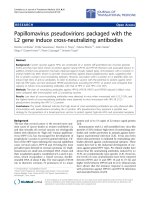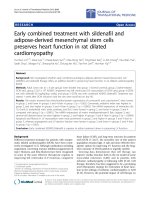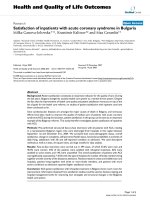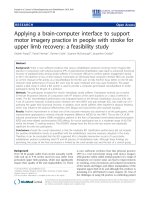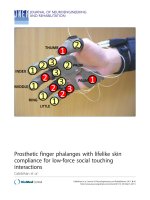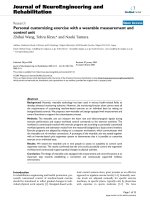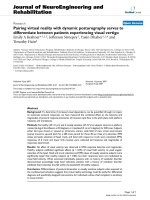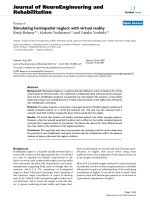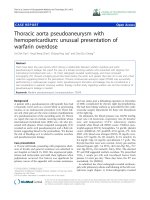Báo cáo hóa học: " Chaotic signal reconstruction with application to noise radar system" pptx
Bạn đang xem bản rút gọn của tài liệu. Xem và tải ngay bản đầy đủ của tài liệu tại đây (412.62 KB, 8 trang )
RESEARCH Open Access
Chaotic signal reconstruction with application to
noise radar system
Lidong Liu
*
, Jinfeng Hu, Zishu He, Chunlin Han, Huiyong Li and Jun Li
Abstract
Chaotic signals are potentially attractive in engineeri ng applications, most of which require an accurate estimation
of the actual chaotic signal from a noisy background. In this article, we present an improved sy mbolic dynamics-
based method (ISDM) for accurate estimating the initial condition of chaotic signal corrupted by noise. Then, a
new method, called piecewise estimation method (PEM), for chaotic signal reconstruction based on ISDM is
proposed. The reconstruction performance using PEM is much better than that using the existing initial condition
estimation methods. Next, PEM is applied in a noncoherent reception noise radar scheme and an improved
noncoherent reception scheme is given. The simulation results show that the improved noncoherent scheme has
better correlation performance and range resolution especially at low signal-to-noise ratios (SNRs).
Keywords: Signal processing, noise radar, chaos, parameter estimation
Introduction
Recently, there has been a growing amount of interest in
chaotic signal estimation, which has been applied in the
field of radar and communication [1-8]. In order to
expl oit chaotic signals in engineering applications, there
is a need of robust and efficient algorithms for recon-
structing signals in the presence of n oise. Initial condi-
tion estimation is an important way to reconstruct the
chaotic signal, because the certain chaotic signal will be
obtained once the initial condition value is estimated
exactly.
Initial condition estimation has been investigated by
many researchers and a variety of algorithms have been
proposed for estimating chaotic signal [8-16]. “Halving
method” (HM) [10] and “ extend halving method”
(EHM) [12] have low computational complexity, but
either HM or EHM is only useful for some special
maps. “Symbolic dynamics-based method ” (SDM) [11]
and “extend symbolic dynamics method” (ESDM) [8]
have very low com putational complexity and they are
useful for general chaotic maps. However, because they
rely heavily on the accurate symbolic sequence, thus the
estimation is not always accurate.
In order to get an accurate method for usual chaotic
maps, in t his article, we present a new method called
improved symbolic dynamics-based method (ISDM), for
initial condition estimation. It makes full use of the
initial condition sensitivity of c haos to get an a ccurate
estimation value. Initial condition sensitivity means that
the two chaotic signals with nearby initial condition will
exponentially diverge from each other. Thus, we notice
that only the estimation value which is the closest to the
true value can make the smallest difference between
estimation signal and the observation signal. Based on
this, the improved SDM is given. In improved SDM, an
approximate estimation value is first got by SDM. Dif-
ferent from SDM, an interval whose center point is the
approximate estimation value is defined according to
the estimation error of SDM, and we let the value in the
interval, which can make the smallest estimation error
between the estimation signal and the observation sig-
nal, be the initial condition value.
Next, a new method called piecewise estimation
method (PEM), for chaotic signal reconstruction is pre-
sented based on improved SDM. PEM can further
enhance the signal reconstruction performance. Since
the initial condition of chaotic signal cannot be esti-
mated exactly in noise, and a small error in the initial
condition will make the reconstruction signal exponen-
tially diverge from true signal. So only using the initial
* Correspondence:
School of Electronic Engineering, University of Electronic Science and
Technology of China, Chengdu, 611731, China
Liu et al. EURASIP Journal on Advances in Signal Processing 2011, 2011:2
/>© 2011 Liu et al; licensee Springer. This is an Open Access article distributed under the terms of the Creative Commons Attribution
License ( which permits unrestricted use, distributi on, and reproduction in any medium,
provide d the original work is properly cited .
condition method for chaotic signal reconstruction may
not obtain the satisfying performance especially at low
SNR. However, chaotic sequence still can be predicted
by small error when the sequence length is smalle r than
the embedding dimension according to the CAO
method [17]. Thus, in the PEM, the whole signa l is first
divided into several appropriate small parts; then esti-
mate initial condition of every part, respectively, and
simultaneously using improved SDM; finally, joint the
estimated signal of every part to recons truct the esti-
mated signal. The reconstruction performance is better
than that using the existing initial condition method.
Then the chaotic signal rec onstruction is applied in
the noncoherent reception noise radar scheme which is
proposed by Venkatasubramanian [1]. In [1], the corre-
lation processing reference signal is reconstructed using
the e xisting initial condition estimation. However, after
our research, we find that the correlation performance
is not so well especially at low SNR. So the PEM for
reconstruction the transmitted signal is used and we
offer an improved noncoherent reception noise radar
scheme. In this scheme, it has the better correlation per-
formance and better range resolution especially at l ow
SNR. What is more, it can also achieve a similar perfor-
mance as the ideal coherent scheme. In this improved
noncoherent scheme, both the delayed transmission
reference signal and the synchronization circuit which is
necessary and difficult to be realized in coherent scheme
[18] are not required.
This article is organized as follows. In “ Initial condi-
tion estimation of chaotic signal based on SDM,” we
present the improved SDM and compare its perfor-
manc e with the other methods. Followed by PEM based
on the improved SDM to reconstruct the estimation sig-
nal, the improved noncoherent reception noise radar
system based on PEM is presented. Simulation results
show that improved noncoherent scheme has better
range resolution and it has nearly the same effect as
that of the ideal coherent reception scheme. Brief con-
clusion of this article is drawn finally.
Initial condition estimation of chaotic signal
based on SDM
In this section, at the beginning the main idea of sym-
bolic dynamics-based method (SDM) is given. Then a
new method for initial condition estimation for chaotic
signal is proposed and its performance is also shown.
SDM
Since our research is based on SDM for initial condition
estimation, we give a brief introduction for SDM.
Let E ={E
0
, E
1
, ,E
q-1
}be a finite disjoint partition of
phase space M,
∪
q−1
i
=
0
E
i
=
M
, E
i
⋂ E
j
=Ø,fori ≠ j.
Assuming that the phase point x(n) is in the i th element
of the partitio n at ti me n. s(n)=i(i Î {0,1, q-1}) is an
assigned symbol. Then, any orbit can be encoded as a
string S ={s(0), s(1), s(n), }, which is called a symbolic
sequence. The above coding naturally determines a
mapping ψ from M to the space of symbolic sequence.
ψ(x(0)) = S ⇔ f
n
x(0) ∈ E
s
(
n
)
⇔ x(0) ∈ f
−n
(E
s
(
n
)
)forn ≥
0
(1)
where f
n
denote s the n-fold composition, f
-n
is the nth
order inverse function of f and f
-n
(E
s(n)
)isthesetof
points that map to set E
s(n)
after n iterations. A
sequence S is admissible if there exits at least one initial
condition x(0 ) such that ψ(x(0)) = S.TheSDMusing
the following equation for estimation initial condition:
ˆ
x(0|N)=f
−1
s
(
0
)
· f
−1
s
(
1
)
···f
−1
s
(
N−1
)
(η
)
(2)
where h is a point in the domain of
f
−1
s
(
N−1
)
, S ={s(0), s
(1), , s(n), s(N-1)} (s(n)=i, i Î {0,1,2, }) is a symbolic
sequence obtained from the its measurement sequence.
An illustration example for understanding this is the
Logistic map f(x)=μx(1-x), (|x| ≤ 1, 0 ≤ μ ≤ 4). The
enerating partition consists of two parts: E
0
= [0,0.5)
and E
1
= [0.5,1]. Then, the symbolic sequence is
obtained according to
s(n)=
0, x(n) < 0.5
,
1, x(n) ≥ 0.5.
(3)
The two inverse mapping are given by:
f
−1
s
(x)=
1+(2s − 1)
1 − 4x/μ
2
s =0,1
.
(4)
Then, the initial condition of Logistic map can be esti-
mated using Equation 2.
SDM has low computational compl exity and it is use-
ful f or general chaotic map. However, SDM cannot get
the exact initial condition value and the estimation error
is about 1/2
N
[11]. Since chaotic signal is very sensitive
to initial conditi on and a small error in initial condition
can make large difference as the iteration grows. So a
more accurate method for estimating the initial condi-
tion is needed.
ISDM
In this part, an ISDM is proposed based on chaotic
initial sensitivity character.
Though SDM cannot get the exact estimation, the
idea of SDM still can be used to get an approximate
estimation, and the estimation error is about 1/2
N
[11].
In our article, a more accurate estimation can be got
based on the chaotic initial condition sensitivity. The
chaotic initial condition sensitivity means the two sig-
nals with nearby init ial condition will exponentially
diverge from each other. Thus, the estimation signal
Liu et al. EURASIP Journal on Advances in Signal Processing 2011, 2011:2
/>Page 2 of 8
error has a close relationship to the initial condition
error. So the initial condition could be obtained indir-
ectly by computing the error between the observation
signal and the signal generated by the initial condition
in a special interval.
Based on this, in this article, a uniform search with M
sampling points over the interval
l =[
ˆ
x
(
0
)
− 1/2
−N
,
ˆ
x
(
0
)
+1/2
−N
]
is made, where
ˆ
x
(
0
)
is
the estimation value using Equation 2. Then estimation
value is got in l by the rule that which can make the mini-
mum difference between the estimation signal and the
observation signal. This can be illustrated in Equation 5.
ˆ
x(0) = arg inf
ˆ
x
(
0
)
∈l
y(x(0), N) − x(
ˆ
x(0), N)
(5)
where inf(f(x)) denotes the infimum of f(x),
|
|x(n)|| =
x(n), x
∗
(n)
, y(x(0), N) is the obtained signal
and it consists of chaotic signal and additive noise,
x
(
ˆ
x
(
0
)
, N
)
is the estimation signal, N is the length of the
sequence.
The step of improved SDM is summarized as follows.
(1) Compute the suboptimal value
ˆ
x
(
0
)
by Equation 2
according to the observation signal.
(2) A uniform search over the interval
l =[
ˆ
x
(
0
)
− 1/2
N
,
ˆ
x
(
0
)
+1/2
N
]
is made, where i =1,2
M and M is the total sampling number in l.
(3) The initial condition estimation is obtained by
picking up the special value which can make the mini-
mum difference between the estimation signal and the
obtained signal using Equation 5.
Simulation analysis of initial condition estimation
To validate the accuracy of the improved SDM, we do
experiments on the Logistic map and Chebyshev map.
The Logistic map is described as f(x)=μx(1-x), (|x| ≤
1, 0 ≤ μ ≤ 4).
The C hebyshev map is described as f(x)=cos(k cos
-1
(x)), (|x| ≤ 1).
Cramer-Rao lower bound (CRLB) for both of the
maps is computed by Equation 6 quoted from [19].
var(
ˆ
x
0
) ≥ J
−1
(x
0
)=
1
−E
∂
2
ln p(y|x
0
)
∂
2
x
0
≈ σ
2
r
λ
2
− 1
λ
2N
− 1
(6)
where l is the Lyapunov number and
σ
2
r
is the noise
power.
For the Logistic map, let μ =4,x (0) = 0.6534, M =
1000, and N = 10. The comparison of CRLB which is
computed by Equation 6, the proposed method, SDM,
and HM [10] are shown in Figure 1.
For the Chebyshev map, let k =4,x
0
= 0.3411, M =
1000, and N = 10. The comparison of CRLB which is
computed by Equat ion 6 in [20], the proposed method
and SDM is shown in Figure 2.
Figures 1 and 2 indicate that the proposed method is
more accurate especially at low SNR. Here, we should
know the proposed method cannot be obtained at arbi-
trary low SNR. The performance of estimators for chao-
tic systems tends to degrade quite suddenly a s the SNR
decreases below some threshold SNR (SNR
th
)[18,21].
When the SNR is below SNR
th
, which means the
entropy of the chaotic signal exceeds the channel capa-
city, t he initial condition estimation performance is not
well. In the improved SDM, using Equation 7 which is
obtained from [21], we can get SNR
th
which is nearly
8.67 dB in the Logistic map in experiment 1. By the
same way we obtain SNR
th
is nearly 6.54 dB in the Che-
byshev map in experiment 2. In this a rticle, the SNR is
given more than SNR
th
.WecanseefromFigures1and
2, every estimation method nearly reaches the CRLB
when the SNR is much more than SNR
th
. When the
SNR is close to SNR
th
, the estimation error becomes
10
15 20 25 30
35 40 45
50 55 6
0
-110
-100
-90
-80
-70
-60
-50
-40
-30
-20
-10
SNR
(
dB
)
MSE(dB)
CRLB
Improved SDM
SDM
ESDM
HM
Figure 1 Comparison of CRLB, the proposed method in this
paper, SDM in [13], ESDM in [7]and HM in [10]. The chaotic
signal is a Logistic map under zero-mean additive white Gaussian
noise.
10 15
20 25
30 35
40 45
50
55 6
0
-160
-140
-120
-100
-80
-60
-40
-20
0
SNR
(
dB
)
MSE(dB)
CRLB
Improved SDM
SDM
ESDM
Figure 2 Comparison of CRLB, the proposed method in this
paper, SDM in [13]and ESDM in [7]. The chaotic signal is a
Chebyshev map under zero-mean additive white Gaussian noise.
Liu et al. EURASIP Journal on Advances in Signal Processing 2011, 2011:2
/>Page 3 of 8
worse. But when the SNR is low (a little more than
SNR
th
), the estimation performance of the proposed
method is better than the existing methods shown in
Figures 1 and 2, because it makes full use of the initial
condition sensitivity of chaos.
SNR
th
=
αe
2λ
− 1
αδ
r
2
(e
2Nλ
− 1)E
N−1
n=0
f
n
(x
0
)
2
−1
(7)
where a is the parameter in the chaotic map (for Che-
byshev map a = k and for Logistic map a = μ), SNR
th
is
the threshold SNR,
σ
2
r
is the noise power, N is the length
of chaotic sequence and l is the Lyapunov number.
PEM
In this section, the PEM (the schematic diagram is
showninFigure3)isproposed.Itisamoreaccurate
way to reconstruct the estimated signal.
The aim of using t he PEM is to improve the signal
reconstruction accuracy. In engineering, the initial con-
dition may n ot be estimated perfectly accurately, and
“ the extreme sensitivity of a chaotic system’ ssteady
state response to small changes in its initial conditions
makes long term prediction of the evolution o f such a
system difficult, if not impossible” [20]. Thus, the chao-
tic signal reconstruction for long sequence may not
reach the ideal effect only using the initial condition
estimation method. However, chaos also has the deter-
ministic characteristic, and it can be predicted in short
time according to CAO method [17]. Thus, if the
sequence of the chaotic signal is short, even if there is a
change in the initial condition, the error between the
reconstructed signal and the real signal is small. So
divid ing the whole received signal into several appropri-
ate small parts can improve the signa l estimation accu-
racy. The remaining question is how to define the
length of the small part.
Define the length of the small part is different for dif-
ferent chaotic maps, but the way is almost the sa me.
Here, we use the Logistic map as an example to illustrate
it. First, we see Figure 4 which shows the relationship
between the sequence length and the initial conditi on
estimation error of the improved SDM for Logistic map.
It is clear that the initial condition error does not
decrease much when the sequence length is more than a
certain number (in Figure 4, the certain number is 8
when SNR = 20 dB) at certain SNR. We know that if the
initial condition is fixed, the sequence reconstruction
error becomes bigger when the sequence length
increases. So if the sequence length is more than 8, the
reconstruction error is more than that of the sequence
with length 8 at SNR = 20 dB. Thus, we only need to
compute the reconstruction error of the sequence with
the length 1-8. After computation and comparing, we
find that when the sequence length is 7, the reconstruc-
tion error is the smallest. So, we let the le ngth of every
small part is 7 for the Logistic map at SNR = 20 dB.
The main idea of PEM is: first divide the received sig-
nal into several appropriate small parts; then estimate
the initial condition of every part, respectively, and
simultaneously using the improved SDM; finally, joint
the estimated signal of every part to reconstruct the esti-
mated signal. The schematic diagram of the PEM is
given in Figure 3.
To validate the analysis above, Figures 5, 6, and 7
show the signal reconstructed by the method in this
article, the signal reconstructed by HM and by ESDM,
respectively. We can se e clearly that the reconstruction
error of using the PEM in this article is the smallest.
One reason is it divides the long sequence into small
part. The other reason is the improved SDM is used in
every small part to enhance the initial condition estima-
tion accuracy.
Improved noncoherent reception noise radar
scheme
In this section, an improved noncoherent reception
noise radar scheme is given, and its better range resolu-
tion is also shown.
initial condition estimation
ĂĂ
ĂĂ
ĂĂ
reconstructed signal
1
(0)
N
x
(0)
N
x
1
(0)x
2
(0)x
Part 1 Part 2 Part N-1 Part N
Part 1 Part 2 Part N-1 Part N
reveived signal
Figure 3 The schematic diagram of the piecewise estimation
method.
0 2
4 6
8 10
12 14
16
18 2
0
-60
-55
-50
-45
-40
-35
-30
-25
-20
-15
-10
Sequence Length
Estimator Error(dB)
10dB
15dB
20dB
Figure 4 The relationship between the sequence length and
the initial condition estimation error for Logistic map.
Liu et al. EURASIP Journal on Advances in Signal Processing 2011, 2011:2
/>Page 4 of 8
The noise radar scheme is shown in Figure 8. In Figure
8, in the right red dashed l ine frame, the coherent
method is shown as the conventional way while in the
left red dashed line frame the noncoherent method
which is proposed by Venkatasubramanian [1] is shown.
X(t) is the transmitted signal generated by noise source
and X(t-T
r
) is the returned signal from the target with T
r
=2R/c and R isthedistancefromtheradar.Themain
difference between the coherent system and the nonco-
herent system is that, the latter using the reconstructed
transmitted signal X’(t-T
d
) but not the t ransmitted signal
X(t-T
d
) delayed by the delay lines, to correlate with the
returned signal (T
d
is the delayed time by the delay lines).
This can avoid some difficult problems, such as main-
taining a distortion-free line and getting accurate syn-
chronization of the transmitted signal [1].
In this article, we do further research in noncoherent
reception noise radar scheme, and the improving point
is on the transmitted signal reconstruction. The trans-
mitted signal reconstruction in [1] is just using the
existing initial condition estimation method. But here,
the transmitted signal reconstruction is using PEM. In
doing so, the reconstruction error is much smaller than
that caused by just using the existing initial condition
estimation method especially at low SNR. The reason is
that: dividing the whole received signal into several
small parts enhances the reconstruction accuracy; using
the improved SDM decreases the initial condition esti-
mation error in every divided part.
In order to illustrate the effect of the improved
scheme, we use the correlation processing performance
to show the advance, since the target range resolution
can be obtained from it. Let us consider a radar trans-
mitted signal X(t). Denote the received signal by Y(t).
Furthermore, we consider a point target located at the
range R along the radar line of sight. Then, the received
signal can be written as
Y
(
t
)
= X
(
t − T
r
)
+ n
(
t
)
(8)
where T
r
=2R/c is the round-trip delay time, n(t)is
the white Gauss noise. The correlation of the recon-
struction signal X’ (t) and received signals Y(t)canbe
written as
R(τ )=
T
int
0
Y(t)X
∗
(t − τ )d
t
(9)
0
20 40 60
80 100 120 140
160 180
-1
-0.5
0
0.5
1
1
.5
Tim
e
A
mp
li
tu
d
e
True signal
Reconstructed signal
0 20 40 60 80 100 120 140 160 18
0
-0.1
0
0.1
0.2
0.3
0.4
0.5
0.6
0.7
0.8
0.9
Tim
e
Error
Figure 5 Chaotic signal reconstructed by the piecewise method at SNR = 10 dB, the chaotic map is the Logistic map, the mean error
of the reconstructed signal is 0.0041.
0 20
40 60
80 100
120 140
160
180
-1
-0.5
0
0.5
1
1
.5
Tim
e
A
mp
li
tu
d
e
Real signal
Reconstructed signal
0 20
40 60
80 100
120 140
160
18
0
0
0.2
0.4
0.6
0.8
1
1.2
1.4
1.6
1.8
2
Tim
e
Error
Figure 6 Chaotic signal reconstructed by HM in [10]at SNR = 10 dB, the chaotic map is the Logistic map, the mean error of the
reconstructed signal is 0.6841.
Liu et al. EURASIP Journal on Advances in Signal Processing 2011, 2011:2
/>Page 5 of 8
where T
int
is the available correlation time. In the
noiseless case, the maximum value |R(τ)| is at the point
τ = T
r
Let us analyze the expected value of Equation 9
as
E[R(τ )] = E
⎡
⎣
T
int
0
Y(t)X
∗
(t − τ )dt
⎤
⎦
=
T
int
0
E
Y(t)X
∗
(t − τ )
dt
=
T
int
0
E
X
∗
(t − T
r
)X
∗
(t − τ )
+ E
n(t)X
∗
(t − τ )
d
t
=
T
int
0
R
XX
(τ − T
r
)dt +
T
int
0
E
n(t)X
∗
(t − τ )
dt
(10)
Since the emitted signal X(t) is the chaotic signal, thus
the reconstructed signal X’ (t)andthenoisen(t)are
independent processes. Then the second term in Equa-
tion 10 is equal to zero and we obtain
E[R
(
τ
)
]=T
int
R
XX
(
τ − T
r
)
(11)
Since the autocorrelation function’ s maximum is at τ
=0,thedelaytimeT
r
can be estimated as the position
of the maximum as
0 20 40
60 80 100 120 140 160 180
-1
-0.5
0
0.5
1
1.5
Tim
e
A
mp
li
tu
d
e
Real signal
Reconstructed signal
0 20 40
60 80 100 120 140 160 18
0
0
0.2
0.4
0.6
0.8
1
1.2
1.4
1.6
1.8
2
Tim
e
Error
Figure 7 Chaotic signal reconstr ucted by ESDM in [7]at SNR = 10 dB, the chaotic map is the Logistic map, the mean error of the
reconstructed signal is 0.6646.
Noise Sources
Delay Line
Mixer
Correlation processing
V
R
Transmitted Signal
Reconstruction
()
()
d
d
Xt T
Xt T
c
|
()
d
Xt T
()Xt
()
r
Xt T
Figure 8 The basic schematic diagram of noise radar scheme.
940
960
980 1000
1020 1040
1060
-40
-35
-30
-25
-20
-15
-10
-5
0
n
dB
Figure 9 The correlation processing performance using the
traditional ideal coherent way with no noise.
Liu et al. EURASIP Journal on Advances in Signal Processing 2011, 2011:2
/>Page 6 of 8
T
r
=max
τ
E[R(τ )]
(12)
Thus, we can obtain the target range resolution form
T
r
by R = cT
r
/2.
The correlation simulation is given next. Let a station-
ary target 30 m from the radar. Let X(t)bechaoticsig-
nal generated by the Chebyshev map, and the SNR is
40, 20, 10 dB, respec tively . The signal bandwidth is 200
MHz , the sampling frequency is 1 GMHz and the puls e
length is 1 μs. In order to show the criterion, the co rre-
lation processing performance using the traditional ideal
coherent way with no noise is shown in Figure 9 first.
Then, the correlation processing performance using the
PEM in this article is shown in Figure 10, and the corre-
lation processing perfor mance using the existing initial
condition estimation method as [1] described is shown
in Figure 11.
When using the method in this article, the correlation
performance has nearly the same effect as that using the
traditional ideal coherent way, and the peak value of the
correlation function is clear even at low SNR. We can
get the estimated delay time T
r
easily using Equation 12
and the ran ge resolution can be obtained by R = T
r
c/2.
The range reso lution of the two methods is shown in
Table1.WecanseefromTable1thateverymethod
can get an approximate resolution at high SNR, but the
method in this article has advantage at low SNR.
Conclusion
In this article, we developed an improved SDM for
accurate estimating the initial condition of chaotic signal
in noise. A new method called PEM is then given. The
PEM develops a new way to reconstruct the chaotic
signal.
Based on the PEM, an improved noncoherent recep-
tion noise radar system is developed. It uses the recon-
structed signal to correlate with the received signal. The
simulation results show that improved noncoherent
scheme has better correlation performance and range
resolution than just using the existing initial condition
estimation method. It has nearly the same effect as that
of the ideal coherent reception scheme, and its
A
940 960
980 1000
1020
1040 1060
-40
-35
-30
-25
-20
-15
-10
-5
0
n
dB
B
940 960 980 1000 1020 1040 1060
-40
-35
-30
-25
-20
-15
-10
-5
0
n
dB
C
940
960
980
1000
1020
1040
1060
-40
-35
-30
-25
-20
-15
-10
-5
0
n
dB
Figure 10 Correlation sum over chaotic signal samples, the reference signal is the reconstructed signal which is obtained by using
the method in this paper. (A) SNR = 40 dB; (B) SNR = 20 dB; (C) SNR = 10 dB.
A
940 960
980 1000
1020
1040 1060
-40
-35
-30
-25
-20
-15
-10
-5
0
n
dB
B
940 960 980 1000 1020 1040 1060
-40
-35
-30
-25
-20
-15
-10
-5
0
n
dB
C
940 960
980 1000
1020 1040
1060
-40
-35
-30
-25
-20
-15
-10
-5
0
n
dB
Figure 11 Correlation sum over chaotic signal samples, the ref erence signal is the reconstructed signal which is obtained using the
existing initial condition method as Ref. [1]. (A) SNR = 40 dB; (B) SNR = 20 dB; (C) SNR = 10 dB.
Table 1 Range resolution of different methods
SNR
(dB)
Range resolution (method in
[1]) (m)
Range resolution (method in
[22]) (m)
Range resolution (method in
[23]) (m)
Range resolution (method in this
article) (m)
40 33 32.3 28.7 30.8
20 35 34.5 27.6 28.5
10 N/A N/A 22.8 32.3
Liu et al. EURASIP Journal on Advances in Signal Processing 2011, 2011:2
/>Page 7 of 8
realization is cheaper and easier than the coherent
reception scheme since the d elayed transmission refer-
ence signal and the synchronization circuits are not
required.
Abbreviations
CRLB: Cramer-Rao lower bound; EHM: extend halving method; ESDM: extend
symbolic dynamics method; HM: Halving method; ISDM: improved symbolic
dynamics-based method; PEM: piecewise estimation method; SNR: signal-to-
noise ratios; SDM: symbolic dynamics-based method.
Acknowledgements
The authors would like to thank the suggestions of the anonymous
reviewers. And the authors would like to thank the support of Defense Pre-
research Fund (9140A07011609DZ0216), the Fundamental Research Funds
for the Central Universities (ZYGX2009J011, ZYGX2009J015, ZYGX2010J015,
103.1.2-E022050205).
Competing interests
The authors declare that they have no competing interests.
Received: 22 November 2010 Accepted: 13 May 2011
Published: 13 May 2011
References
1. V Venkatasubramanian, H Leung, A novel chaos-based high-resolution
imaging technique and its application to through-the-wall imaging. IEEE
Signal Process Lett. 12(7):528–531 (2005)
2. H Leung, Yu H, K Murali, Ergodic chaos-based communication schemes.
Phys Rev E. 66(9):036203(1)–036203(8) (2002)
3. PD Huang, YM Pi, ZQ Zhao, Weak GPS signal acquisition algorithm based
on chaotic oscillator. EURASIP J Adv Signal Process
4. H Leung, S Shanmugam, N Xie, SC Wang, An ergodic approach for chaotic
signal estimation at low SNR with application to ultra-wide-band
communication. IEEE Trans Signal Process. 54(5):1091–1103 (2006)
5. D Ghosh, Adaptive scheme for synchronization-based multiparameter
estimation from a single chaotic time series and its applications. Phys Rev E.
78(5):056211(1)–056211(5) (2008)
6. JF Hu, JB Guo, Breaking a chaotic secure communication scheme. CHAOS.
18, 01321(1)–01321(7) (2008)
7. LF Yu, Y Zhao, RR Ni, T Li, Improved adaptive LSB steganography based on
chaos and genetic algorithm. EURASIP J Adv Signal Process
8. K Wang., et al, Symbolic vector dynamics approach to initial condition and
control parameters estimation of coupled map lattices. IEEE Trans Circ Syst
I. 55(4):1116–1124 (2008)
9. S Kay, Asymptotic maximum likelihood estimator performance for chaotic
signals in noise. IEEE Trans Signal Process. 43(4):1009–1012 (1995)
10. S Kay, V Nagesha, Methods for chaotic signal estimation. IEEE Trans Signal
Process. 43(8):2013–2016 (1995). doi:10.1109/78.403367
11. C Ling, X Wu, S Sun, A general efficient method for chaotic signal
estimation. IEEE Trans Signal Process. 47(5):1424–1428 (2008)
12. S Wang, P Yip, H Leung, Estimating initial conditions of noisy chaotic
signals generated by piecewise linear Markov maps using itineraries. IEEE
Trans Signal Process. 47(12):3289–3302 (1999). doi:10.1109/78.806073
13. F Lu, D Xu, G Wen, Estimation of initial conditions and parameters of a
chaotic evolution process from a short time series. CHAOS. 14(4):1050–1055
(2004). doi:10.1063/1.1811548
14. S Jorg, S Thomas, Symbolic dynamics for processing chaotic signals–I: noise
reduction of chaotic sequences. IEEE Trans Circ Syst I Fundam Theory Appl.
48(11):1269–1282 (2001). doi:10.1109/81.964416
15. S Jorg, S Thomas, Symbolic dynamics for processing chaotic signals–II:
communication and coding. IEEE Trans Circ Syst I Fundam Theory Appl.
48(11):1283–1295 (2001). doi:10.1109/81.964417
16. K Wang, WJ Pei, ZY He, YM Cheung, Estimating initial conditions in coupled
map lattices from noisy time series using symbolic vector dynamics. Phys
Lett A. 367(6):316–321 (2007)
17. L Cao, Practical method for determining the minimum embedding
dimension of a scalar time series. Physica D. 110(12):43–50 (1997)
18. DF Drake, DB Williams, Linear, random representations of chaos. IEEE Trans
Signal Process. 55(4):1379–1389 (2007)
19. M Eisencraft, LA Baccala, The Cramer-Rao bound for initial conditions
estimation of chaotic orbits. Chaos, Solitons Frac. 38(10):132–139 (2008)
20. DF Drake, DB Williams, On error function selection for the analysis of
nonlinear time series. Proceedings of the IEEE International Conference on
Acoustics, Speech, and Signal Processing, vol. V, San Francisco, CA. 329–332
(1992)
21. H Hen, N Merhav, On the threshold effect in the estimation of chaotic
sequences. IEEE Trans Inf Theory. 50(10):2894–2904 (2004)
22. BC Flores, E Solis, G Thomas, Assessment of chaos-based FM signals for
range-Doppler imaging. IEEE Proc Radar Sonar Navig. 150(4):3–15 (2003)
23. S Qiao, ZG Shi, KS Chen, A new architecture of UWB radar utilizing
microwave chaotic signals and chaos synchronization. Prog Electromag Res.
75, 225–237 (2007)
doi:10.1186/1687-6180-2011-2
Cite this article as: Liu et al.: Chaotic signal reconstruction with
application to noise radar system. EURASIP Journal on Advances in Signal
Processing 2011 2011:2.
Submit your manuscript to a
journal and benefi t from:
7 Convenient online submission
7 Rigorous peer review
7 Immediate publication on acceptance
7 Open access: articles freely available online
7 High visibility within the fi eld
7 Retaining the copyright to your article
Submit your next manuscript at 7 springeropen.com
Liu et al. EURASIP Journal on Advances in Signal Processing 2011, 2011:2
/>Page 8 of 8
